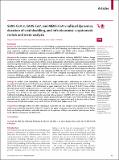SARS-CoV-2, SARS-CoV, and MERS-CoV viral load dynamics, duration of viral shedding, and infectiousness : a systematic review and meta-analysis
Date
01/2021Metadata
Show full item recordAbstract
Background Viral load kinetics and duration of viral shedding are important determinants for disease transmission. We aimed to characterise viral load dynamics, duration of viral RNA shedding, and viable virus shedding of severe acute respiratory syndrome coronavirus 2 (SARS-CoV-2) in various body fluids, and to compare SARS-CoV-2, SARS-CoV, and Middle East respiratory syndrome coronavirus (MERS-CoV) viral dynamics. Methods In this systematic review and meta-analysis, we searched databases, including MEDLINE, Embase, Europe PubMed Central, medRxiv, and bioRxiv, and the grey literature, for research articles published between Jan 1, 2003, and June 6, 2020. We included case series (with five or more participants), cohort studies, and randomised controlled trials that reported SARS-CoV-2, SARS-CoV, or MERS-CoV infection, and reported viral load kinetics, duration of viral shedding, or viable virus. Two authors independently extracted data from published studies, or contacted authors to request data, and assessed study quality and risk of bias using the Joanna Briggs Institute Critical Appraisal Checklist tools. We calculated the mean duration of viral shedding and 95% CIs for every study included and applied the random-effects model to estimate a pooled effect size. We used a weighted meta-regression with an unrestricted maximum likelihood model to assess the effect of potential moderators on the pooled effect size. This study is registered with PROSPERO, CRD42020181914. Findings 79 studies (5340 individuals) on SARS-CoV-2, eight studies (1858 individuals) on SARS-CoV, and 11 studies (799 individuals) on MERS-CoV were included. Mean duration of SARS-CoV-2 RNA shedding was 17·0 days (95% CI 15·5–18·6; 43 studies, 3229 individuals) in upper respiratory tract, 14·6 days (9·3–20·0; seven studies, 260 individuals) in lower respiratory tract, 17·2 days (14·4–20·1; 13 studies, 586 individuals) in stool, and 16·6 days (3·6–29·7; two studies, 108 individuals) in serum samples. Maximum shedding duration was 83 days in the upper respiratory tract, 59 days in the lower respiratory tract, 126 days in stools, and 60 days in serum. Pooled mean SARS-CoV-2 shedding duration was positively associated with age (slope 0·304 [95% CI 0·115–0·493]; p=0·0016). No study detected live virus beyond day 9 of illness, despite persistently high viral loads, which were inferred from cycle threshold values. SARS-CoV-2 viral load in the upper respiratory tract appeared to peak in the first week of illness, whereas that of SARS-CoV peaked at days 10–14 and that of MERS-CoV peaked at days 7–10. Interpretation Although SARS-CoV-2 RNA shedding in respiratory and stool samples can be prolonged, duration of viable virus is relatively short-lived. SARS-CoV-2 titres in the upper respiratory tract peak in the first week of illness. Early case finding and isolation, and public education on the spectrum of illness and period of infectiousness are key to the effective containment of SARS-CoV-2.
Citation
Cevik , M , Tate , M , Lloyd , O , Maraolo , A E , Schafers , J & Ho , A 2021 , ' SARS-CoV-2, SARS-CoV, and MERS-CoV viral load dynamics, duration of viral shedding, and infectiousness : a systematic review and meta-analysis ' , The Lancet Microbe , vol. 2 , no. 1 , pp. e13-e22 . https://doi.org/10.1016/S2666-5247(20)30172-5
Publication
The Lancet Microbe
Status
Peer reviewed
ISSN
2666-5247Type
Journal article
Collections
Items in the St Andrews Research Repository are protected by copyright, with all rights reserved, unless otherwise indicated.

